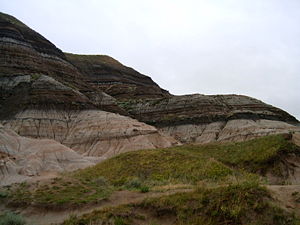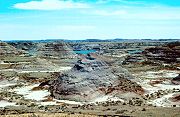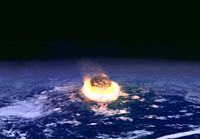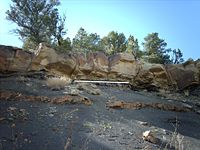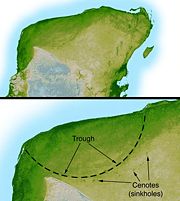Cretaceous–Tertiary extinction event
2008/9 Schools Wikipedia Selection. Related subjects: Ancient History, Classical History and Mythology; Geology and geophysics
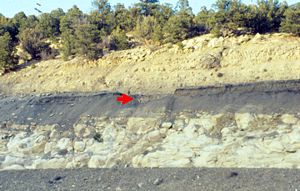
The Cretaceous–Tertiary extinction event was a large-scale mass extinction of animal and plant species in a geologically short period of time, approximately (Ma). It is widely known as the K–T extinction event and is associated with a geological signature, usually a thin band dated to that time and found in various parts of the world, known as the K–T boundary. K is the traditional abbreviation for the Cretaceous Period derived from the German name Kreidezeit, and T is the abbreviation for the Tertiary Period (a historical term for the period of time now covered by the Paleogene and Neogene periods). The event marks the end of the Mesozoic Era and the beginning of the Cenozoic Era. "Tertiary" being no longer recognized as a formal time or rock unit by the International Commission on Stratigraphy, the K-T event is now called the Cretaceous—Paleogene (or K-Pg) extinction event by many researchers.
Non-avian dinosaur fossils are only found below the K–T boundary and became extinct immediately before or during the event. A very small number of dinosaur fossils have been found above the K–T boundary, but they have been explained as reworked, that is, fossils that have been eroded from their original locations then preserved in later sedimentary layers. Mosasaurs, plesiosaurs, pterosaurs and many species of plants and invertebrates also became extinct. Mammalian and bird clades passed through the boundary with few extinctions, and evolutionary radiation from those Maastrichtian clades occurred well past the boundary. Rates of extinction and radiation varied across different clades of organisms.
Scientists theorize that the K–T extinctions were caused by one or more catastrophic events such as massive asteroid impacts or increased volcanic activity. Several impact craters and massive volcanic activity in the Deccan traps have been dated to the approximate time of the extinction event. These geological events may have reduced sunlight and hindered photosynthesis, leading to a massive disruption in Earth's ecology. Other researchers believe the extinction was more gradual, resulting from slower changes in sea level or climate.
Extinction patterns
During the Maastrichtian stage of the Cretaceous, there was already a progressive decline in biodiversity prior to the ecological crisis indicated by the K–T boundary. After the K–T event, biodiversity required substantial time to recover, despite the existence of abundant vacant ecological niches.
Even though the boundary event was severe, there was significant variability in the rate of extinction between and within different clades. Because atmospheric particles blocked sunlight, reducing the amount of solar energy reaching the earth's surface, species that depended on photosynthesis declined or became extinct. Photosynthesizing organisms, including phytoplankton and land plants, formed the foundation of the food chain in the late Cretaceous as they do today. Evidence suggests that herbivorous animals died out when the plants they depended on for food became scarce; consequently, top predators such as Tyrannosaurus rex also perished.
Coccolithophorids and molluscs, including ammonites, rudists, freshwater snails and mussels, and those organisms whose food chain included these shell builders, became extinct or suffered heavy losses. For example, it is thought that ammonites were the principal food of mosasaurs, a group of giant marine reptiles that became extinct at the boundary.
Omnivores, insectivores and carrion-eaters survived the extinction event, perhaps because of the increased availability of their food sources. At the end of the Cretaceous there seem to have been no purely herbivorous or carnivorous mammals. Mammals and birds that survived the extinction fed on insects, worms, and snails, which fed on dead plant and animal matter. Scientists hypothesize that these organisms survived the collapse of plant-based food chains because they fed on detritus.
In stream communities, few groups of animals became extinct; because stream communities rely less directly on food from living plants and more on detritus that washes in from land, buffering them from extinction. Similar, but more complex patterns have been found in the oceans. Extinction was more severe among animals living in the water column, than among animals living on or in the sea floor. Animals in the water column are almost entirely dependent on primary production from living phytoplankton, while animals living on or in the ocean floor feed on detritus or can switch to detritus feeding.
The largest air-breathing survivors of the event, crocodilians and champsosaurs, were semi-aquatic and had access to detritus. Modern crocodilians can live as scavengers and can survive for months without food, and their young are small, grow slowly, and feed largely on invertebrates and dead organisms or fragments of organisms for their first few years. These characteristics have been linked to crocodilian survival at the end of the Cretaceous.
Microbiota
The K–T boundary represents one of the most dramatic turnovers in the fossil record for various calcareous nanoplankton that formed the calcium deposits that gave the Cretaceous its name. The turnover in this group is clearly marked at the species level. Statistical analysis of marine losses at this time suggests that the decrease in diversity was caused more by a sharp increase in extinctions than by a decrease in speciation. The K–T boundary record of dinoflagellates is not as well-understood, mainly because only microbial cysts provide a fossil record, and not all dinoflagellate species have cyst-forming stages, thereby likely causing diversity to be underestimated. Recent studies indicate that there were no major shifts in dinoflagellates through the boundary layer.
Radiolaria have left a geological record since at least the Ordovician times, and their mineral fossil skeletons can be tracked across the K-T boundary. There is no evidence of mass extinction of these organisms, and, there is support for high productivity of these species in Southern high latitudes as a result of cooling temperatures in the early Paleocene. Approximately 46% of diatom species survived the transition from the Cretaceous to the Upper Paleocene. This suggests a significant turnover in species, but not a catastrophic extinction of diatoms, across the K–T boundary.
The occurrence of Planktonic foraminifera across the K-T boundary has been studied since the 1930s. Research spurred by the possibility of an impact event at the K-T boundary resulted in numerous publications detailing planktonic foraminiferal extinction at the boundary. However, there is debate ongoing between groups that believe the evidence indicates substantial extinction of these species at the K-T boundary, and those who believe the evidence supports multiple extinctions and expansions through the boundary.
As the biomass in the ocean is thought to have decreased during the K-T event, numerous species of benthic foraminifera went extinct, presumably since they depend on organic debris for nutrients. However, as the marine microbiota recovered, it is thought that increased speciation of benthic foraminifera resulted from the increase in food sources. Phytoplankton recovery in the early Paleocene provided the food source to support large benthic foraminiferal assemblages, which are mainly detritus-feeding. Ultimate recovery of the benthic populations occurred over several stages lasting several hundred thousand years into the early Paleocene.
Marine invertebrates
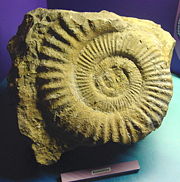
There is variability in the fossil record as to the extinction rate of marine invertebrates across the K-T boundary. The apparent rate is influenced by the lack of fossil records rather than actual extinction.
Ostracodes, a class of small crustaceans that were prevalent in the upper Maastrichtian, left fossil deposits in a variety of locations. A review of these fossils shows that ostracode diversity was lower in the Paleocene than any other time in the Tertiary. However, current research cannot ascertain whether the extinctions occurred prior to or during the boundary interval itself.
Approximately 60% of late-Cretaceous Scleractinia coral genera failed to cross the K-T boundary into the Paleocene. Further analysis of the coral extinctions shows that approximately 98% of colonial species, ones that inhabit warm, shallow tropical waters, went extinct. The solitary corals, which generally do not form reefs and inhabit colder and deeper (below the photic zone) areas of the ocean were less impacted by the K-T boundary. Colonial coral species rely upon symbiosis with photosynthetic algae, which collapsed due to the events surrounding the K-T boundary. However, the use of data from coral fossils to support K-T extinction and subsequent Paleocene recovery must be weighed against the changes that occurred in coral ecosystems through the K-T boundary.
The numbers of cephalopod, echinoderm, and bivalve genera exhibited significant diminution after the K-T boundary. Most species of brachiopods, a small phylum of marine invertebrates, survived the K-T event and diversified during the early Paleocene.
Except for nautiloids (represented by the modern order Nautilida) and coleoids (which had already diverged into modern octopodes, squids, and cuttlefish) all other species of the molluscan class Cephalopoda went extinct at the K-T boundary. These included the ecologically significant belemnoids, as well as the ammonoids, a group of highly diverse, numerous, and widely distributed shelled cephalopods. Researchers have pointed out that the reproductive strategy of the surviving nautiloids, which rely upon few and larger eggs, played a role in outsurviving their ammonoid counterparts through the extinction event. The ammonoids utilized a planktonic strategy of reproduction (numerous eggs and planktonic larvae), which would have been devastated by the K-T boundary event. Additional research has shown that subsequent to this elimination of ammonoids from the global biota, nautiloids began an evolutionary radiation into shell shapes and complexities theretofore known only from ammonoids.
Approximately 35% of echinoderm genera went extinct at the K-T boundary, although taxa that thrived in low-latitude, shallow-water environments during late Cretaceous had the highest extinction rate. Mid-latitude, deep-water echinoderms were much less affected at the K-T boundary. The pattern of extinction points to habitat loss, specifically the drowning of carbonate platforms, the shallow-water reefs in existence at that time, by the extinction event.
Other invertebrate groups, including rudists (reef-building clams) and inoceramids (giant relatives of modern scallops), also became completely extinct at the K-T boundary.
Fish
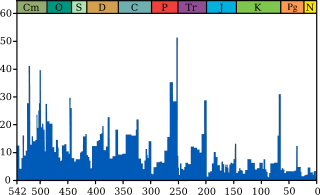
There are substantial fossil records of jawed fishes across the K–T boundary, which provides good evidence of extinction patterns of these classes of marine vertebrates. Within cartilaginous fish, approximately 80% of the sharks, rays, and skates families survived the extinction event, and fewer than 10% of teleost fish (bony fish) families became extinct. There is evidence of a mass kill of bony fishes at a fossil site immediately above the K-T boundary layer on Seymour Island near Antarctica. It is speculated that fish were undergoing environmental stresses and the K-T boundary event may have precipitated the mass extinction. However, the marine and freshwater environments of fishes mitigated environmental effects of the extinction event.
Terrestrial invertebrates
Insect damage to the fossilized leaves of flowering plants from fourteen sites in North America were used as a proxy for insect diversity across the K–T boundary and analyzed to determine the rate of extinction. Researchers found that Cretaceous sites, prior to the extinction event, had rich plant and insect-feeding diversity. However, during the early Paleocene, flora were relatively diverse with little predation from insects, even 1.7 million years after the extinction event.
Terrestrial plants
There is overwhelming evidence of global disruption of plant communities at the K-T boundary. However, there were important regional differences in plant succession. In North America, the data suggest massive devastation and mass extinction of plants at the K-T boundary sections, although there were substantial megafloral changes before the boundary.
In high southern hemisphere latitudes, such as New Zealand and Antarctica the mass die-off of flora caused no significant turnover in species, but dramatic and short-term changes in the relative abundance of plant groups. In North America, approximately 57% of plant species became extinct. The Paleocene recovery of plants began with recolonizations by fern species, represented as a fern spike in the geologic record; this same type of fern recolonization was observed after the 1980 Mount St. Helens eruption.
Due to the wholesale destruction of plants at the K–T boundary, there was a proliferation of saprotrophic organisms such as fungi that do not require photosynthesis and utilize nutrients from decaying vegetation. The dominance of fungal species lasted only a few years while the atmosphere cleared and there was plenty of organic matter to feed on. Once the atmosphere cleared, photosynthetic organisms like ferns and other plants returned.
Amphibians
There is no evidence of K–T boundary mass extinctions of amphibians, and there is strong evidence that most amphibians survived the event relatively unscathed. Several in-depth studies of salamander genera in fossil beds in Montana show that six of seven genera were unchanged after the event.
Frog species appear to have survived into the Paleocene with few species becoming extinct. However, the fossil record for frog families and genera is uneven. An extensive survey of three genera of frogs in Montana show that they were unaffected by the K–T event and survived apparently unchanged. The data show little or no evidence for extinction of amphibian families that bracket the K–T event. Amphibian survival resulted from the clade's ability to seek shelter in water or to build burrows in sediments, soil, wood, or beneath rocks.
Non-archosaur reptiles
The two living non- archosaurian reptile taxa, testudines (turtles) and lepidosaurs ( snakes, lizards, and worm lizards), along with choristoderes (semi-aquatic archosauromorphs which died out in the early Miocene), survived through the K–T boundary. Over 80% of Cretaceous turtle species passed through the K-T boundary. Additionally, all six turtle families in existence at the end of the Cretaceous survived into the Tertiary and are represented by current species.
Living lepidosaurs include Rhynchocephalia and Squamata. The Rhynchocephalia, or tuatara, were a widespread and relatively successful group of lepidosaurs in the early Mesozoic, but began to decline by the mid-Cretaceous. They are represented today by a single genus located exclusively in New Zealand.
The order Squamata, which is represented today by lizards, snakes, and amphisbaenia, radiated into various ecological niches during the Jurassic and were successful throughout the Cretaceous. They survived through the K-T boundary and are currently the most successful and diverse group of living reptiles with more than 6,000 extant species. No known family of terrestrial squamates went extinct at the boundary, and fossil evidence indicates they did not suffer any significant decline in numbers. Their small size, adaptable metabolism, and ability to move to more favorable habitats were key factors in their survivability during the late Cretaceous and early Paleocene.
Non-archosaurian marine reptiles including mosasaurs and plesiosaurs, giant aquatic reptiles that were the top marine predators, went extinct by the end of the Cretaceous.
Archosaurs
The archosaur clade includes two living orders, crocodilians (of which Alligatoridae, Crocodylidae and Gavialidae are the only surviving families) and birds, along with the extinct non-avian dinosaurs and pterosaurs.
Crocodylomorphs
Ten families of crocodilians or their close relatives are represented in the Maastrichtian fossil records, of which five died out prior to the K-T boundary. Five families have both Maastrichtian and Paleocene fossil representatives. All of the surviving families of crocodilians inhabited freshwater and terrestrial environments, except for the Dyrosauridae which lived in freshwater and marine locations. Approximately 50% of crocodilian representatives survived across the K-T boundary, the only apparent trend being that no large crocodiles, such as the giant North American crocodile Deinosuchus, survived. Crocodilian survivability across the boundary may have resulted from their aquatic niche and ability to burrow, which reduced susceptibility to negative environmental effects at the boundary. Jouve and colleagues suggested in 2008 that dyrosaurid juveniles lived in freshwater environments like modern marine crocodile juveniles, which would have helped them survive where other marine reptiles went extinct; freshwater environments were not as strongly affected by K-T events as marine environments.
Pterosaurs
Only one family of pterosaurs, Azhdarchidae, was definitely present in the Maastrichtian, and it went extinct at the K-T boundary. These large pterosaurs were the last representatives of a declining group that contained 10 families during the mid-Cretaceous. Smaller pterosaurs went extinct prior to the Maastrichtian during a period that saw a decline in smaller animal species while larger species became more prevalent. While this was occurring, modern birds were undergoing diversification and replacing archaic birds and pterosaur groups, possibly due to direct competition, or they simply filled empty niches.
Birds
Most paleontologists regard birds as the only surviving dinosaurs (see Origin of birds). However, all non- neornithean birds became extinct, including flourishing groups like enantiornithines and hesperornithiforms. Several analyses of bird fossils show divergence of species prior to the K-T boundary, and that duck, chicken and ratite bird relatives coexisted with non-avian dinosaurs. Neornithine birds survived the K-T boundary as a result of their abilities to dive, swim, or seek shelter in water and marshlands. Many species of birds can build burrows, or nest in tree holes or termite nests, all of which provided shelter from the environmental effects at the K-T boundary. Long-term survival past the boundary was assured as a result of filling ecological niches left empty by extinction of dinosaurs.
Dinosaurs

More has been published about the extinction of dinosaurs at the K-T boundary than any other group of organisms. Excepting a few controversial claims, it is agreed that all non-avian dinosaurs went extinct at the K-T boundary. The dinosaur fossil record has been interpreted to show both a decline in diversity and no decline in diversity during the last few million years of the Cretaceous, and it may be that the quality of the dinosaur fossil record is simply not good enough to permit researchers to distinguish between the choices. Since there is no evidence that late Maastrichtian nonavian dinosaurs could burrow, swim or dive, they were unable to shelter themselves from the worst parts of any environmental stress that occurred at the K-T boundary. It is possible that small dinosaurs (other than birds) did survive, but they would have been deprived of food as both herbivorous dinosaurs would have found plant material scarce, and carnivores would have quickly found prey to be in short supply.
Several researchers have stated that the extinction of dinosaurs was gradual and are considered Paleocene dinosaurs. These arguments are based on the discovery of dinosaur remains in the Hell Creek Formation up to 1.3 metres (4 ft 3 in) above and 40,000 years later than the K–T boundary. Pollen samples recovered near a fossilized hadrosaur femur recovered in the Ojo Alamo Sandstone at the San Juan River indicate that the animal lived during the Tertiary, approximately 64.5 mya (about 1 million years after the K–T event). If their existence past the K-T boundary can be confirmed, these hadrosaurids would be considered a Dead Clade Walking. Current research indicates that these fossils were eroded from their original locations and then re-buried in much later sediments (reworked).
Mammals
All major Cretaceous mammalian lineages, including monotremes (egg-laying mammals), multituberculates, marsupials and placentals, dryolestoideans, and gondwanatheres survived the K–T event, although they suffered losses. In particular, marsupials largely disappeared from North America and the Asian deltatheroidans, primitive relatives of extant marsupials, went extinct. In the Hell Creek beds of North America, at least half of the ten known multituberculate species and all eleven marsupial species are not found above the boundary.
Mammalian species began diversifying approximately 30 million years prior to the K-T boundary. Diversification of mammals stalled across the boundary. Current research indicates that mammals did not explosively diversify across the K-T boundary, despite the environment niches made available by the extinction of dinosaurs. Several mammalian orders have been interpreted as diversifying immediately after the K-T boundary, including Chiroptera (bats) and Cetartiodactyla (a diverse group that today includes whales and dolphins and even-toed ungulates), although recent research concludes that only marsupial orders diversified after the K-T boundary.
K-T boundary mammalian species were generally small, comparable in size to rats; this small size would have helped them to find shelter in protected environments. In addition, it is postulated that some early monotremes, marsupials, and placentals were semiaquatic or burrowing, as there are multiple mammalian lineages with such habits today. Any burrowing or semiaquatic mammal would have had additional protection from K-T boundary environmental stresses.
Evidence
North American fossils
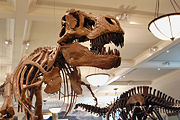
In North American terrestrial sequences, the extinction event is best represented by the marked discrepancy between the rich and relatively abundant late-Maastrichtian palynomorph record and the post-boundary fern spike.
At present the most informative sequence of dinosaur-bearing rocks in the world from the K–T boundary is found in western North America, particularly the late Maastrichtian-age Hell Creek Formation of Montana, USA. This formation, when compared with the older (~75 mya) Judith River/ Dinosaur Park Formations (from Montana and Alberta, Canada, respectively) provides information on the changes in dinosaur populations over the last 10 million years of the Cretaceous. These fossil beds are geographically limited, covering only part of one continent.
The middle–late Campanian formations show a greater diversity of dinosaurs than any other single group of rocks. The late Maastrichtian rocks contain the largest members of several major clades: Tyrannosaurus, Ankylosaurus, Pachycephalosaurus, Triceratops and Torosaurus, which suggests food was plentiful immediately prior to the extinction.
In addition to rich dinosaur fossils, there are also plant fossils that illustrate the reduction in plant species across the K-T boundary. In the sediments below the K–T boundary the dominant plant remains are angiosperm pollen grains, but the actual boundary layer contains little pollen and is dominated by fern spores. Normal pollen levels gradually resume above the boundary layer. This is reminiscent of areas blighted by volcanic eruptions, where the recovery is led by ferns which are later replaced by larger angiosperm plants.
Marine fossils
The mass extinction of marine plankton appears to have been abrupt and right at the K–T boundary. Ammonite genera became extinct at or near the K–T boundary; however, there was a smaller and slower extinction of ammonite genera prior to the boundary that was associated with a late Cretaceous marine regression. The gradual extinction of most inoceramid bivalves began well before the K–T boundary, and a small, gradual reduction in ammonite diversity occurred throughout the very late Cretaceous. Further analysis shows that several processes were in progress in the late Cretaceous seas and partially overlapped in time, then ended with the abrupt mass extinction.
Duration
The length of time taken for the extinction to occur is a controversial issue, because some theories about the extinction's causes require a rapid extinction over a relatively short period (from a few years to a few thousand years) while others require longer periods. The issue is difficult to resolve because of the Signor-Lipps effect; that is, the fossil record is so incomplete that most extinct species probably died out long after the most recent fossil that has been found. Scientists have also found very few continuous beds of fossil-bearing rock which cover a time range from several million years before the K–T extinction to a few million years after it.
Geological cause of extinctions
There have been several theories on the cause of the K-T boundary which led to the massive extinction. These theories have centered on either impact events or increased volcanism; some include elements of both. A scenario combining three major postulated causes: volcanism, marine regression, and extraterrestrial impact has been proposed. In this scenario, terrestrial and marine communities were stressed by the changes in and loss of habitats. Dinosaurs, as the largest vertebrates, were the first to be affected by environmental changes, and their diversity declined. At the same time, particulate materials from volcanism cooled and dried areas of the globe. Then, an impact event occurred, causing collapses in photosynthesis-based food chains, both in the already-stressed terrestrial food chains and in the marine food chains. The major difference between this hypothesis and the single-cause hypotheses is that its proponents view the suggested single causes as either not sufficient in strength to cause the extinctions or not likely to produce the taxonomic pattern of the extinction.
Impact event
In 1980, a team of researchers consisting of Nobel prize-winning physicist Luis Alvarez, his son geologist Walter Alvarez, and chemists Frank Asaro and Helen Michels discovered that sedimentary layers found all over the world at the Cretaceous–Tertiary boundary contain a concentration of iridium many times greater than normal (30 times and 130 times background in the two sections originally studied). Iridium is extremely rare in the earth's crust because it is a siderophile, and therefore most of it travelled with the iron as it sank into the earth's core during planetary differentiation. As iridium remains abundant in most asteroids and comets, the Alvarez team suggested that an asteroid struck the earth at the time of the K–T boundary. There were other earlier speculations on the possibility of an impact event, but no evidence had been uncovered at that time. There is evidence of a breakup of the parent-body asteroid of 298 Baptistina, which is conjectured to have occurred about 160 Ma BP. It is hypothesized that several fragments from this breakup eventually impacted to form Chicxulub Crater on Earth, and Tycho crater on the Moon.
The consequence of an impact would be a dust cloud which would block sunlight for a year or less, and an injection of sulfuric acid aerosols into the stratosphere, leading to a 10–20% reduction in sunlight reaching the earth's surface and inhibit photosynthesis. It would have taken at least ten years for those aerosols to dissipate. which would account for the extinction of plants and phytoplankton, and of organisms dependent on them (including predatory animals as well as herbivores). Small creatures whose food chains were based on detritus had a reasonable chance of survival. The consequences of reentry of ejecta into Earth's atmosphere included a brief (hours long) but intense pulse of infrared radiation of an intensity, killing exposed organisms. Global firestorms may have resulted from the heat pulse and the fall of incendiary fragments from the blast back to Earth. High O2 levels during the late Cretaceous would have supported intense combustion. The level of atmospheric O2 plummeted in the early Tertiary Period. If widespread fires occurred, they would have increased the CO2 content of the atmosphere and caused a temporary greenhouse effect once the dust cloud settled, and this would have exterminated the most vulnerable organisms that survived the period immediately after the impact.
The impact may also have produced acid rain, depending on what type of rock the asteroid struck. However, recent research suggests this effect was relatively minor, lasting for approximately 12 years. The acidity was neutralized by the environment, and the survival of animals vulnerable to acid rain effects (such as frogs) indicate this was not a major contributor to extinction. Impact theories can only explain very rapid extinctions, since the dust clouds and possible sulfuric aerosols would wash out of the atmosphere in a fairly short time—possibly under ten years. Subsequent research, however, identified the Chicxulub Crater buried under Chicxulub on the coast of Yucatan, Mexico as the impact crater which matched the Alvarez hypothesis dating. Identified in 1990 based on the work of Glen Penfield done in 1978, this crater is oval, with an average diameter of about 180 kilometers (112 mi), about the size calculated by the Alvarez team.
The shape and location of the crater indicate further causes of devastation in addition to the dust cloud. The asteroid landed in the ocean and would have caused tsunamis, for which evidence has been found in several locations in the Caribbean and eastern United States—marine sand in locations which were then inland, and vegetation debris and terrestrial rocks in marine sediments dated to the time of the impact. The asteroid landed in a bed of gypsum (calcium sulfate), which would have produced a vast sulfur dioxide aerosol. This would have further reduced the sunlight reaching the earth's surface and then precipitated as acid rain, killing vegetation, plankton and organisms which build shells from calcium carbonate ( coccolithophores and molluscs). Most paleontologists now agree that an asteroid did hit the Earth about 65 Ma BP, but there is an ongoing dispute whether the impact was the sole cause of the extinctions.
Deccan Traps
Before 2000, arguments that the Deccan Traps flood basalts caused the extinction were usually linked to the view that the extinction was gradual, as the flood basalt events were thought to have started around 68 mya and lasted for over 2 million years. The most recent evidence shows that the traps were in fact erupted over 800,000 years spanning the K-T boundary, and therefore may be responsible for the extinction and the delayed biotic recovery thereafter.
The Deccan Traps could have caused extinction through several mechanisms, including the release of dust and sulfuric aerosols into the air which might have blocked sunlight and thereby reduced photosynthesis in plants. In addition, Deccan Trap volcanism might have resulted in carbon dioxide emissions which would have increased the greenhouse effect when the dust and aerosols cleared from the atmosphere.
In the years when the Deccan Traps theory was linked to a slower extinction, Luis Alvarez (who died in 1988) replied that paleontologists were being misled by sparse data. While his assertion was not initially well-received, later intensive field studies of fossil beds lent weight to his claim. Eventually, most paleontologists began to accept the idea that the mass extinctions at the end of the Cretaceous were largely or at least partly due to a massive Earth impact. However, even Walter Alvarez has acknowledged that there were other major changes on Earth even before the impact, such as a drop in sea level and massive volcanic eruptions that produced the Indian Deccan Traps, and these may have contributed to the extinctions.
Multiple impact event
Several other craters also appear to have been formed about the time of the K–T boundary. This suggests the possibility of near simultaneous multiple impacts, perhaps from a fragmented asteroidal object, similar to the Shoemaker-Levy 9 cometary impact with Jupiter. Among these are the Boltysh crater, a 24 kilometers (15 mi) diameter impact crater in Ukraine (65.17 ± 0.64 mya), and the Silverpit crater, a 20 kilometers (12 mi) diameter suspected impact crater in the North Sea (60–65 mya). Any other craters that might have formed in the Tethys Ocean would have been obscured by tectonic events like the relentless northward drift of Africa and India.
Maastrichtian sea-level regression
There is clear evidence that sea levels fell in the final stage of the Cretaceous by more than at any other time in the Mesozoic era. In some Maastrichtian stage rock layers from various parts of the world, the later ones are terrestrial; earlier ones represent shorelines and the earliest represent seabeds. These layers do not show the tilting and distortion associated with mountain building, therefore, the likeliest explanation is a "regression", that is, a drop in sea level. There is no direct evidence for the cause of the regression, but the explanation which is currently accepted as the most likely is that the mid-ocean ridges became less active and therefore sank under their own weight.
A severe regression would have greatly reduced the continental shelf area, which is the most species-rich part of the sea, and therefore could have been enough to cause a marine mass extinction. However research concludes that this change would have been insufficient to cause the observed level of ammonite extinction. The regression would also have caused climate changes, partly by disrupting winds and ocean currents and partly by reducing the earth's albedo and therefore increasing global temperatures.
Marine regression also resulted in the loss of epeiric seas, such as the Western Interior Seaway of North America. The loss of these seas greatly altered habitats, removing coastal plains that ten million years before had been host to diverse communities such as are found in rocks of the Dinosaur Park Formation. Another consequence was an expansion of freshwater environments, since continental runoff now had longer distances to travel before reaching oceans. While this change was favorable to freshwater vertebrates, those that prefer marine environments, such as sharks, suffered.
